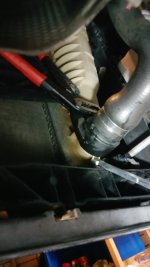I am in the process of replacing the coolant in my 2009 Panda 1.2 Dynamic Eco (no air con) and have a quick query.
I managed (after a lot of hassle) to remove the "quick" connect coupling at the bottom of the radiator and drained the coolant system (thanks to other forum responses). I opened the two bleed valves to help the system drain (one on the radiator near the coolant expansion cap and the other behind and between the airbox/battery. This was a static drain on a cold engine and I did not run the engine. Only around 3L of coolant has come out, which is around 2L less than I was expecting.
Where is the rest and is there a way to get it out?
Thanks.
I managed (after a lot of hassle) to remove the "quick" connect coupling at the bottom of the radiator and drained the coolant system (thanks to other forum responses). I opened the two bleed valves to help the system drain (one on the radiator near the coolant expansion cap and the other behind and between the airbox/battery. This was a static drain on a cold engine and I did not run the engine. Only around 3L of coolant has come out, which is around 2L less than I was expecting.
Where is the rest and is there a way to get it out?
Thanks.


